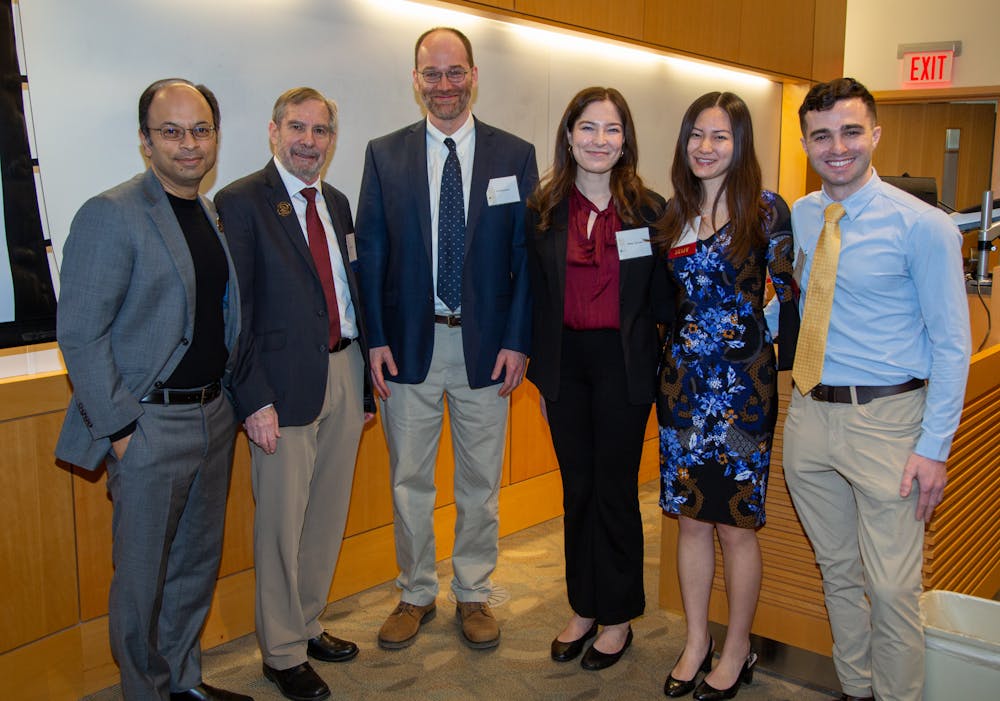Brown’s chapter of the American Physician Scientist Association and the Warren Alpert Medical School hosted the University’s inaugural APSA Conference Saturday. Through panels and presentations, the conference brought together experts and students to discuss how physician-scientists bridge the gap between theoretical research and clinical application in medicine.
The conference featured introductory remarks from Mukesh Jain, dean of medicine and biological sciences, a keynote speech from Douglas Lowy, principal deputy director of the National Cancer Institute, faculty discussion panels and a physician-scientist career panel with Jack Elias, professor of molecular biology, cell biology and biochemistry.
Physician-scientists both generate new medical knowledge and apply it to patient treatment, said Ryan Malpass MD’25, president and co-founder of the APSA Brown chapter. Physician-scientists can range “from a medical doctor publishing clinical research to someone doing (pure) bench science.”
APSA “aims to help physician-scientist trainees realize their educational and professional goals” across the nation, according to the organization’s website. Malpass, who founded Brown’s local chapter last spring alongside John Pham MD’25, the chapter’s vice president, said he hopes to contribute to APSA’s goals in a way that uniquely serves Brown researchers.
Brown’s APSA chapter is working to hold annual conferences, informational sessions for students applying to medical training programs and training sessions for students to build physician-science skills.
“It is a wonderful career to be able to make observations in the hospital (and) in the clinic (and) bring them back (to) understand them in the laboratory with the hope of then going back and impacting human health,” Jain said in his opening remarks. “It is not the path of least resistance … but it is an incredibly rewarding career path.”
Jain’s remarks were followed by a keynote presentation from Lowy titled “Embracing Challenges and Change Throughout a Professional Career.” Lowy discussed his experience as a physician in public policy, as well as his work in the 1980s to develop, characterize and test vaccines for the human papillomavirus, more commonly known as HPV.
Lowy encouraged physician-scientists to pursue their passions with intent and a vision for the future. He concluded his speech with a discussion of medicine in public policy, noting his gratitude at being able “to have an impact beyond (his) own research.”
Lowy achieved “truly breathtaking” accomplishments that “changed science, medicine and the health of millions across the nation and world,” Jain said.
The conference also featured presentations on student- and trainee-led research. Ranjan Mukherjee, a medical transfusion specialist, discussed a new vein detection system he co-developed with his wife Somdatta Goswami, assistant professor of applied mathematics (research), in collaboration with George Karniadakis, professor of applied mathematics and engineering.
Mukherjee and Goswami’s system uses deep learning — a type of artificial intelligence that identifies patterns in data by mimicking human brain processes — to locate veins, allowing clinicians to more easily and accurately find access sites to a patient’s bloodstream.
A physician-scientist himself, Mukherjee described the need for medical practitioners who can “bridge the gap between clinical medicine and bench research.” He explained that there is often a disconnect between theoretical research and the practical medical challenges that physicians face.
Nina Li ’24 MD’28 also presented at the event, detailing a new platform for detecting contamination in mRNA vaccines that she helped develop at the TripathiLaboratory. Li said that physician-scientists can “expand the current boundaries of medicine through their research.”
The conference transitioned into career-related discussions through two simultaneous panels, one for senior experts and one for current trainees. Panelists discussed strategies for success in the field of physician science.
In the future, Malpass said that the Brown APSA chapter hopes to collaborate more with the University, including institutions such as Brown’s School of Public Health and Graduate School of Biology.
“We have a lot of different ways we can go,” Malpass said. APSA is driven to find areas of improvement for physician-science training at Brown and take “action to help address those needs.”
“Our APSA chapter has really positioned themselves to be a voice for aspiring and current physician-scientists at all levels,” Jain said.





